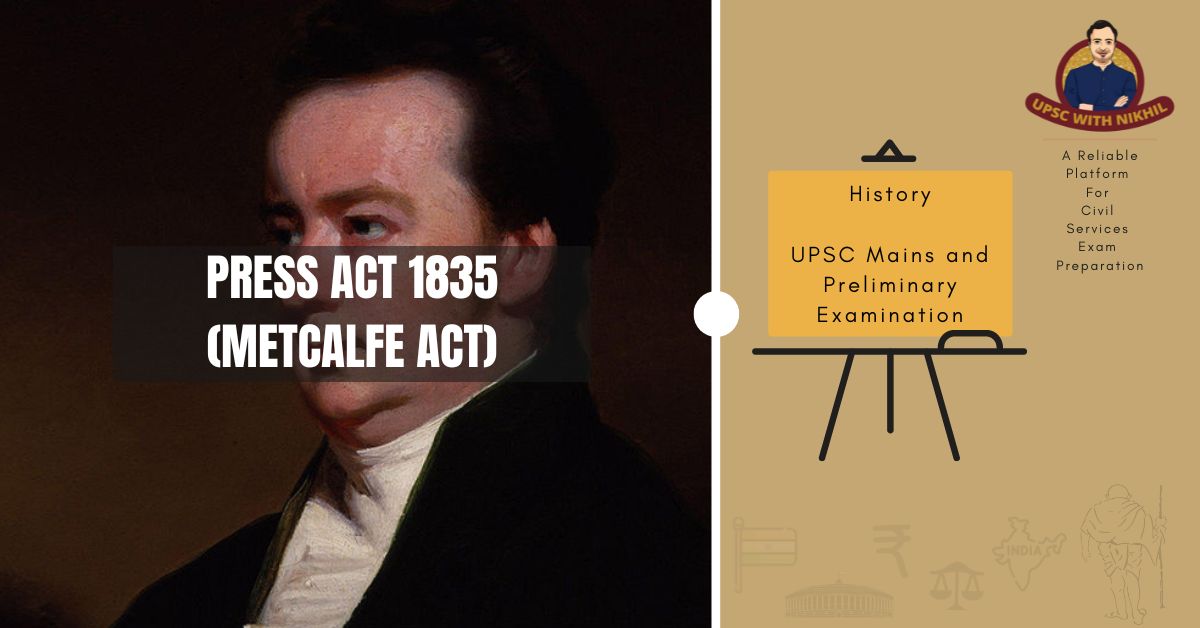Press Act 1835 (metcalfe Act)
Introduction
In 1835, Sir Charles Metcalfe enacted the Press Act, reestablishing press freedom. From 1835 to 1836, Metcalfe served as the governor-general. The offensive 1823 ordinance was overturned by him, gaining him the title "liberator of the Indian press." A printer/publisher was obligated by the new Press Act (1835) to provide a thorough account of the location of a publication and to halt operations if a comparable declaration was made. Newspapers grew quickly as a result of a liberal press policy.
Features Under Press Act 1835
• Indian Press was treated favorably by Governor-general Charles Metcalfe, who also overturned the 1823 rules.
• As a result, this legislation is regarded as the "Metcalfe Act," and Metcalfe is hailed as the "Liberator of the Indian Press."
• This law, which was in effect until 1856, encouraged the nation's newspaper industry to expand quickly.
About Sir Charles Metcalfe
• From March 1835 until March 1836, Sir Charles Metcalfe (1785–1846) held the position of acting governor general of India.
• The son of Thomson Metcalfe, a Major in the army of the East India Company, Charles Metcalfe was born on January 30, 1785, in Kolkata.
• Before coming back to Calcutta in 1801 as a writer working for the Company, he received his education at Bromley and Eton.
• In politics, Metcalfe held a number of jobs. He was crucial in bringing the Amritsar Treaty, which restored stability to Punjab and was in effect until the first Sikh war of 1845, to a successful conclusion with Ranjit Singh.
• The British territories was protected while the Sikhs' attacks on Afghanistan and Sind were deflected.
• The longest-serving Englishman in India was Metcalfe. He landed in India at the height of British supremacy under Lord Wellesley and stayed for 38 years.
• His quest for change prompted him to forbid sati, infanticide, and slavery in the Delhi region as early as 1812.
• Metcalfe, a council member, convinced Governor-General Bentinck to involve indigenous people in running the province. He was a competent government employee who held liberal beliefs.
• The Indians who built Metcalfe Hall in Calcutta and had his bust placed there were drawn to him because of his liberal press policies.
Press Act 1835 - Impact
• The European community in India and the majority of Calcutta's residents, including the most distinguished local gentry in terms of rank and accomplishments, heartily embraced the Act.
• They came together and approved a speech of gratitude to Sir Charles Metcalfe for the gift he had given the nation as well as subscriptions to mark the occasion by building a grand hall in his honor.
• "The Act evinced to the world that the Company's government desired no concealment, that it was happy to have the minutest details of its Indian administration scrutinized," he said in response to the address.
• It showed the universe that it sought knowledge and instruction wherever it could find them and that it wanted to rule India as a beloved, enlightened, and free country rather than as a conquering, uneducated, and oppressed one.
Conclusion
Newspapers played a significant role in the fight for Indian independence. The British government viewed the development and expansion of Indian newspapers as a threat, and as a result, it attempted several steps to stifle them using various acts and regulations. After overturning the offensive 1823 decree, Metcalfe earned the moniker "liberator of the Indian press". Bentink's successor, Lord Metcalfe, assumed control in 1835. Like Bentink, he was a liberal who ardently supported press freedom.


